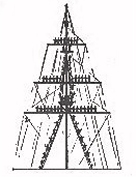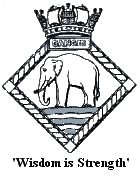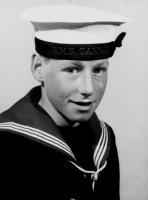A SHORT HISTORY OF H.M.S. GANGES
In 1899 H.M.S. GANGES, an old 2nd rate of 84 guns built in Bombay in 1821, took up station in Harwich harbour. She was there to serve as a training ship for young boys joining the Royal Navy. For seven years the old Ganges served her purpose but a severe winter proved that better conditions were necessary to ensure the well-being of the boys. Thus, the sick quarters were the first permanent building on land that previously had served for recreation purposes only.
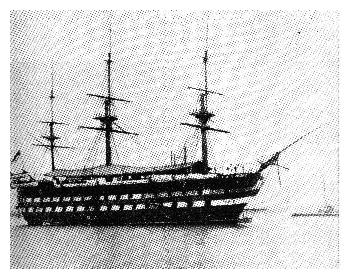
H.M.S. GANGES circa 1899
This move was soon followed by the transfer of most of the training ashore, despite fierce opposition from those who could not envisage sailors being trained on dry land. The old Ganges was eventually towed away to be replaced by Ganges II, which served until 1923 as a gunnery and accommodation ship.
By this time the establishment was virtually the one which lasted until the closure of Ganges in 1976. Incorporated into the plan were two Martello Towers which were built in 1808 as defence against invasion. These two towers still stand, overlooking the harbour.
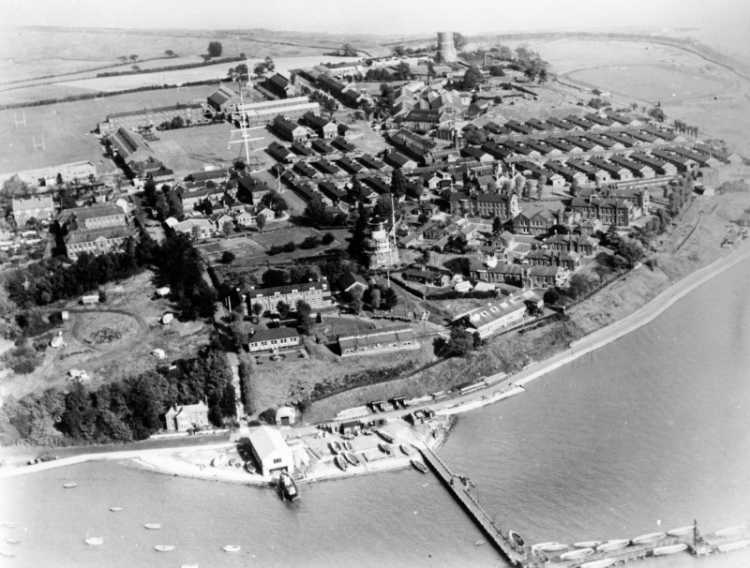
Over all those years the one aim of the Establishment had remained the same. This was to train boys of 15-16 to take their place as responsible sailors in the Fleet. An average of 1,800 per year had passed through since the Second World War. Many of the lads trained here were officers in the Royal Navy, some of whom served in Ganges. Three achieved Flag rank, Admiral Sir Phillip Enright (after whom the Technical training block was named) served in Ganges as a boy and, later, as the Executive Officer.
Training in Ganges was divided into three equally important parts. One was education, which continued the boy's schooling. The second part was his technical training; this taught him the groundwork of the career he would follow when he joined the Fleet. The third was character training, which, in brief, taught him to stand on his own two feet.
THE DIVISIONS
RED SQUADRON
ANSON- Named after Admiral Lord Anson (1697-1762) who was prominent in actions against Spanish colonies in the New World. In 1747 he routed a French fleet, and captured six warships, four merchant ships and gold worth £300,000. Sailed round the world 1740-44.
BENBOW - Named after Vice Admiral Benbow (1653-1712) Master of the fleet in battles against the French off Beachy Head, Barleur and La Hogue. He died fighting the French in the West Indies.
FROBISHER - Named after Sir Martin Frobisher (1535-94) a great Elizabethan navigator, who tried three times to navigate the Northwest passage round Canada. He went with Drake to the West Indies, fought the Spanish Armada, and died fighting the French off Brest.
GRENVILLE - Named after Sir Richard Grenville (1541-91) who went to Virginia with his relative Sir Walter Raleigh and fought against the Armada. Best remembered for his gallant fight in the 'Revenge' against the entire Spanish Fleet off the Azores.
WHITE SQUADRON
COLLINGWOOD - Named after Admiral Lord Collingwood (1750-1810) who took part in many noted battles in the time of Lord Howe and Lord Nelson - 'The Glorious First of June, St. Vincent, Trafalgar (where he was Second in Command to Admiral Nelson.)
DRAKE - Named after Sir Francis Drake (1540-96) who is well known for his exploits against the Spaniards. He was the first Englishman to see the pacific, carried out a particularly bold raid against a Spanish fleet in Cadiz harbour, and played bowls at Plymouth while waiting for the Spanish Armada.
EXMOUTH - Named after Admiral Viscount Exmouth (1757-1833), who was prominent in Nelson's day. By bombarding Algiers he stopped Christian slavery in North Africa.
HAWKE - Named after Admiral Lord Hawke (1705-1781), a great fighter against the French. He lived to become Admiral of the Fleet and First Lord of the Admiralty.
BLUE SQUADRON
BLAKE - Named after General-at-Sea Blake (1598-1657), lawyer, Member of Parliament, soldier and Fleet Commander. He first supported Cromwell against the Royalists and then fought the Dutch and Spaniards at sea. A great Naval reformer.
DUNCAN - Named after Admiral Viscount Duncan (1731-1804), who fought the Spaniards for many years, and won a notable victory over the Dutch at Camperdown in 1797.
KEPPEL - Named after Admiral Viscount Keppel (1725-86) who sailed round the world with Anson. After many fights with the French he became First Lord of the Admiralty, a Member of Parliament and a Peer.
RODNEY - Named after Admiral Lord Rodney (1719-92), who took a distinguished part in many battles against the French and Spaniards. At the battle of Saintes, he crushed a strong French Fleet.
|
